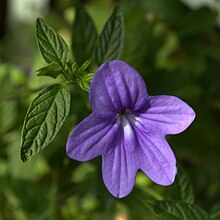Browallia
| Browallia | ||||||||||||
|---|---|---|---|---|---|---|---|---|---|---|---|---|

|
||||||||||||
| Systematics | ||||||||||||
|
||||||||||||
| Scientific name | ||||||||||||
| Browallia | ||||||||||||
| L. |
Browallia is a genus of plants inthe nightshade family (Solanaceae). The sixor so species occur from North to South America .
description

Vegetative characteristics
Browallia species are upright, annual herbaceous plants that reach heights of between 8 and 60 cm or even up to 1 m (in rare cases also 1.5 m). They can be hairless or downy to sticky-downy hairy. The hair consists of simple, multicellular, single-row and glandular trichomes . Glandular trichomes can have a two- or multicellular stem, a single- or multicellular head and are always in a single row. The branching can be weak or strong. There are no Casparian streaks in the endodermis .
The leaves are sessile or stalked 2 to 30 mm long. The membranous leaf blades are up to 6 cm long (rarely up to 9 cm) heart-shaped-ovoid, ovoid-elongated, rhombic or linear-elongated with an almost blunt or pointed upper end. The mesophyll (basic tissue of the leaves) forms drusen dorsiventrally , stomata can be found on both leaf sides.
Inflorescences and flowers
The mostly small flowers are solitary or in racemose inflorescences . The flower stalks are 2 to 40 mm long and grow a little further after the anthesis .
The hermaphroditic flowers have a double flower envelope . The calyx is radially symmetrical , 4 to 20 mm long and tubular-bell-shaped. It is four- or five-toothed or lobed, whereby the teeth or lobes are usually shorter or about the same length as the calyx tube. The corolla tube is (rarely only 1.5) two to four times as long as the calyx, 1 to 20 mm wide and 10 to 52 mm long. The crown is zygomorphic , salver-shaped and occasionally slightly bilobed. It is 63 to 73 mm long, lavender, blue, violet, purple, yellow or cream colored. The coronet is 6 to 52 mm wide and divided into five unequal sized corolla lobes, which can be almost circular, egg-shaped or elongated.
Four fertile stamens are formed, a fifth is reduced to a hump or is completely absent. They start in the upper half of the crown and stand bent down along the front corolla lobes. The anthers of the two upper stamens consist almost of only one counter, the second is rejected or does not exist. The filaments of these two stamens are curved, flattened and hairless or covered with long, occasionally branched trichomes. The stamens of the lower two stamens are usually a little longer (but occasionally also a little shorter) than those of the upper pair of stamens, they are round and narrow, the anthers are 1 mm long and consist of two fertile counters, which are free in the lower half stand apart. The pollen grains are medium-sized with a diameter of 28 to 40 µm. The ovary is hairless or at least in the lower half densely covered with stiff trichomes. Nectaries are thick and circular, but they can also be receded or absent.
Fruits and seeds
The upright capsule fruits are 4.5 to 6 mm long, spherical, elongated or inverted-conical and contain 10 to 45 seeds . The seeds are cubic in shape, angled and (0.5) 1 (1.5) mm long. The seed coat (testa) is reticulated, pitted or warty.
Sets of chromosomes
The basic chromosome number is x = 10 or x = 11, depending on the species.
Systematics and distribution
The genus Browallia was established by Carl von Linné . The generic name Browallia honors the Swedish scientist and clergyman Johan Browall (1707–1755).
Both in the morphologically based systematics of the nightshade family according to Armando Hunziker and in the molecular-biological systematics according to Richard Olmstead , the genus is classified together with the genus Streptosolen in a tribe Browallieae.
A total of at least 17 taxa have been described, of which probably only six species can be recognized as valid.
The Browallia species occur from southern Arizona via Mexico , Central America to Andean South America and to Bolivia .
Here is a selection of the types:
- Browallia americana L. (Syn .: Browallia elata L. )
- Browallia grandiflora Graham
- Browallia speciosa L .: It occurs in Costa Rica, Panama, Colombia and Ecuador.
Locations
Browallia species thrive at altitudes of 500 to 2600 meters. Browallia americana and Browallia speciosa can be found as cultural refugees in disturbed locations.
use
Browallia americana and Browallia speciosa are occasionally used as ornamental plants .
literature
- Armando T. Hunziker: The Genera of Solanaceae. ARG Gantner Verlag KG, Ruggell, Liechtenstein 2001. ISBN 3-904144-77-4 .
Individual evidence
- ↑ Lotte Burkhardt: Directory of eponymous plant names. Extended Edition. Botanic Garden and Botanical Museum Berlin, Free University Berlin Berlin 2018. [1]
- ^ Browallia on the Germplasm Resources Information Network (GRIN), USDA , ARS , National Genetic Resources Program. National Germplasm Resources Laboratory, Beltsville, Maryland. Retrieved November 28, 2017.
